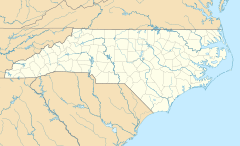Hallsville, North Carolina facts for kids
Quick facts for kids
Hallsville, North Carolina
|
|
|---|---|

The Northeast Cape Fear River at Hallsville
|
|
| Country | United States |
| State | North Carolina |
| County | Duplin |
| Elevation | 39 ft (12 m) |
| Time zone | UTC-5 (Eastern (EST)) |
| • Summer (DST) | UTC-4 (EDT) |
| ZIP code |
28518
|
| Area codes | 910, 472 |
| FIPS code | 37-29080 |
| GNIS feature ID | 1020595 |
Hallsville is a small community located next to the Northeast Cape Fear River in Duplin County, North Carolina, United States. It is not an official town, but a community where people live and work.
Contents
Hallsville's Past
Hallsville has a long history, starting way back in the 1700s. It was once a busy place with a post office and a river port.
Early Settlers and Land
The Hallsville area got its first post office in 1828. Zebulon Simpson was its first postmaster, which is the person in charge of a post office. The post office stayed open until 1930.
In 1736, many families from Scotland and Ireland, called Ulster Scots or Scotch-Irish, moved to this part of North Carolina. A man named Henry McCulloh got a huge piece of land from the King of England. This land, over 71,000 acres, was between the Northeast Cape Fear River and Black River. Hallsville was part of this large land grant.
The Hall Family and Plantations
The community of Hallsville is named after the Hall family. They had lived in the area since the mid-1700s. Thomas Hall owned a large farm called a plantation here. He was also known for selling turpentine, a product from pine trees. Many enslaved people worked on his plantation.
Civil War and River Travel
During the American Civil War, Hallsville saw a brief moment of action. On July 6, 1863, soldiers from the Union army were passing through. Confederate soldiers were chasing them, hoping to trap them at the river. However, the Union soldiers had already crossed the river before the Confederates could set their trap.
By 1890, only 24 people lived in Hallsville. But things changed in 1899 when the steamship Saint Peter started using Hallsville as a loading point. This ship traveled to the port of Wilmington. Hallsville would send out lumber and naval stores (like tar and pitch from trees) on the ship. Because of the steamship, more people started to move to Hallsville.
Changes and Decline
Traveling on the upper part of the "Northeast River" was difficult for steamships. The river could be dangerous. In 1916, the Kinston Carolina Railroad Company built new train tracks. These tracks went through the eastern part of Duplin County but bypassed Hallsville.
The next year, a nearby town called Beulaville became an official town. Beulaville was built at a good spot where several main roads met. This made Beulaville more important than Hallsville. Slowly, most of Hallsville's residents moved away, leaving only a few families behind.
Important People from Hallsville
Hallsville has been home to some interesting people who made a difference.
William Hall
William Hall (1741-1825) was a successful merchant and an important person in Hallsville. In 1776, he served as a Justice of the Peace in Duplin County. A Justice of the Peace is like a local judge who helps keep order and settles small legal matters.
Parker David Robbins
Parker (P.D.) Robbins (1834-1917) was a remarkable person. He was a Black man whose family had Native American roots. During the Civil War, he fought for the Union army as a sergeant in a cavalry unit made up of Black soldiers.
After the war, Robbins returned home and was chosen to represent his county at the State Constitutional Convention. This was a meeting where people decided how the state government would work. He also served in the State Legislature from 1869 to 1870, helping to make laws for North Carolina. Later, he became a postmaster.
Robbins was also a clever farmer and inventor. He even got patents for two farm machines he invented. Around 1879, he moved to Hallsville. There, he started a sawmill and built the steamship Saint Peter. He operated this ship for the rest of his life. Parker Robbins is buried in Duplin County.
James Sprunt
James Sprunt (1818-1884) was born in Scotland. He wanted to move to New York to become a teacher. But on his way, his ship was damaged in a storm and had to stop in Wilmington, North Carolina, for repairs. While in Wilmington, Sprunt heard that Hallsville needed a teacher.
Sprunt decided to take the teaching job in Hallsville and taught there for five years. After that, he moved to Grove Academy in nearby Kenansville. During the Civil War, Sprunt served as a pastor for soldiers in the 20th North Carolina Infantry. He left his position in 1863 because he became sick.
After the war, Sprunt held several important jobs in Duplin County. He was the Register of Deeds, which means he kept records of land ownership. He was also the County Clerk. James Sprunt was also a successful botanist, someone who studies plants. He sold many plants to the National Botanical Gardens in Washington, D.C. He is buried in Hallsville, on a small hill overlooking the Northeast Cape Fear River.



